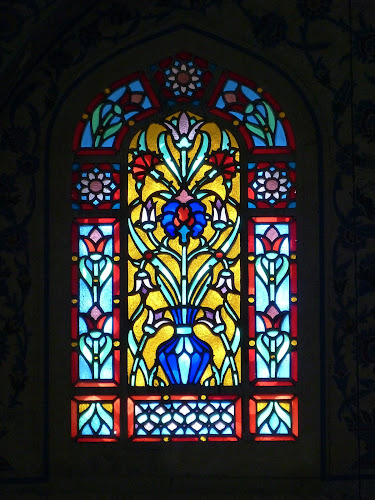Art forms of Islamic Architecture
There are many art forms of Islamic Architecture which include:
- Ceramics.
- Girih tiling and woodwork.
- Jali.
- Kilim.
- Leather.
- Metalwork.
- Muqarnas.
- Stained glass.
- Zellige.
Ceramics :
Ceramic is the rich heritage of the Islamic world that has a unique aesthetic identity characterized by geometric patterns and calligraphy design.
It lends itself to circular motifs, whether radical or tangential. Bowls or plates can be decorated inside or out with radial lines. These may b stylized leaves or flower patterns or flower petals.
These patterns applied in Islamic architecture since the Ayyubid Period, 13th century A.D.
Girih tiling and woodwork :
Girih is decorative Islamic Geometric patterns used in architecture and handicraft objects. It elaborates five standardized shapes. This style used in Persian Islamic Architecture and also used in decorative woodwork. These Girih designs are traditionally made in different media including cut brickwork, stucco, and mosaic tilework, in the Safavid period.
Jali :
Jali is pierced stone screens with regularly repeating patterns. They are characteristic of Indo-Islamic Architecture. For example, In Mughal dynasty buildings.
In addition, geometric designs combine octagons and pentagons with other shapes. Jali functions as windows or room dividers. It provides privacy but allows light and air. It forms a prominent element of architecture in India.
Kilim :
A kilim is an Islamic flatwoven carpet. It used for households also as a prayer mat. Kilim motifs are often symbolic.
And they are usually decorative. Kilim patterns are often characterized by specific regions.
Leather :
Islamic leather is usually embossed with patterns almost like those already described. Leather book covers, starting with the Quran where figurative artwork was excluded, where decorated with a mixture of Kufic script, medallions, and geometric patterns, typically boarded by geometric braiding.
Metalwork :
Metal artifacts share an equivalent geometric design that's utilized in other sorts of Islamic art. Geometric designs in Islamic metalwork can form a grid decorated with other motifs or they will form a background pattern.
Muqarnas :
Muqarnas is a carved ceiling to semidomes often utilized in mosques. They are made from Stucco, also made up of wood, brick, and stone. They are characteristics of the Middle age of Spain and Morroco in Islamic Architecture. They are usually decorated.
Stained glass:
Stained glass is used during a sort of settings in Islamic Architecture. It is used for surviving summers. Constructed in 1797 in the Palace of Shaki Khans, Azerbaijan.
There are 6 to 8 pointed stars in the Pattern of stained glass. Tradition stained glass was in a wooden frame. These decorative windows are the features of the Palaces architecture.
Zellige :
These are glazed terracotta tiles set into plaster, forming colorful glazed patterns. This is the tradition of Morroco but it is also found in Moorish Spain. Mostly, it is used for the adornment of the Mosque, Public buildings, and private houses.
Stay tuned for more information. Thank you.








Very informative. Nicely done. Keep up the good work.
ReplyDeleteVery Informative 👍🏻
ReplyDeleteInformative
ReplyDeletebeautiful arts describe
ReplyDeleteVery informative article! Keep sharing 👍
ReplyDeleteVery good
ReplyDeleteVery beautifully explained
ReplyDeleteIts good
ReplyDeletegood work
ReplyDeleteyou are incrrasing our knowledge thankyou
ReplyDelete